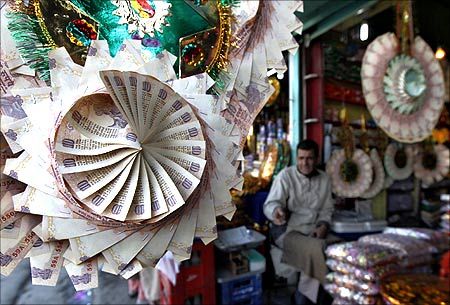 Data on the real value of the currency against other currencies tells a different story, says Abheek Barua.
Data on the real value of the currency against other currencies tells a different story, says Abheek Barua.
The general sense in the financial markets is that the rupee is somewhat "fairly" valued at this stage and might just see small depreciation in line with the persistent inflation differentials with trading partners.
The data on the "real" value of the currency might tell a different story.
The September 2014 Reserve Bank of India (RBI) monthly bulletin shows an real effective exchange rate or REER (a weighted average of the exchange rates against trading partners adjusted for inflation differences) index level of around 117 for August, compared to the base of 2004-05.
This uses trade (imports plus exports) with six major trading as weights. The index prints at around 108 if export weights are used. Going by the thumb rule that the markets tend to use, this would suggest "overvaluation" of the rupee of 17 and 8 per cent respectively.
These incidentally, use the consumer price index to build in the inflation differentials.
I am perhaps over-interpreting things a bit but the RBI governor's categorical assertion in his post-policy interaction with the press that the rupee might appear weak against the dollar but was strong against other currencies seemed to hint at the growing strength of the rupee in real terms.
My experience of the markets suggests that when depreciation pressure suddenly builds up (for instance, in a phase of global risk aversion), the market suddenly wakes up to these valuation metrics and justifies any sharp downward movement as the "obvious" consequence of overvaluation.
This is a risk we need to bear in mind in predicting the rupee's future.
There are, of course, problems with this interpretation of overvaluation. For instance, there might not be a compelling reason for still treating 2004-05 as the equilibrium or base year.
If the base year is brought forward, the extent of overvaluation diminishes. In the extreme case, if we take 2013-14 as a base year (as the RBI does along with its 2004-05 series), the extent of overvaluation is a meagre 3.75 per cent.
Then there is the the Balassa-Samuelson theorem that states that if the real appreciation of the rupee reflects productivity gains (higher productivity for labour, for instance, fetches higher wages that feeds into higher prices that in turn pushes the REER up) then that's a good thing.
This should be netted out from the REER to arrive at a fair value. The problem is that productivity data is difficult to get.
There is also evidence based on a couple of studies that the utilisation rates of capital as well as total factor productivity (the bit that measures the efficiency with which the factors of production are combined) have declined sharply over the last couple of years.
It is reasonable, I would argue, to assume that productivity growth of labour has simultaneously declined. Thus, the overvaluation in the REER might not be offset by compensating productivity gains.
I am not trying to be alarmist here. However, labour market data in the US seems to make an increasingly compelling case for the US Fed to hike rates.
The latest print for the Job Openings and Labour Turnover Survey showed that job openings in August climbed to their highest level in 13 years.
This could mean that even if inflation stays benign, the need to "stay ahead of the curve" might force the US central bank to hike rates earlier than what the majority of market participants are expecting.
The minutes of the US power monetary policy committee meeting on September 16 and 17 released last Thursday brought some succour to the markets by talking about the risks associated with a strong dollar in a weak global economic environment. However, the Fed is known to change its mind as the flow of data changes.
The reason for the current mayhem in the commodity markets is difficult to fathom but one can't afford to take one's eye off that ball.
A level of around $90 for Brent crude seemed quite unimaginable just a couple of months ago. The optimists will argue that this trend should bode well for a net commodity importer like India.
The pessimists will ask if the commodity market is the first domino to fall as the US prepares to reverse its interest rate stance and wonder which asset class will come next. If it happens to be emerging markets, then having an overvalued currency would hardly help our case.
The writer is with ICRIER. These views are personal.











